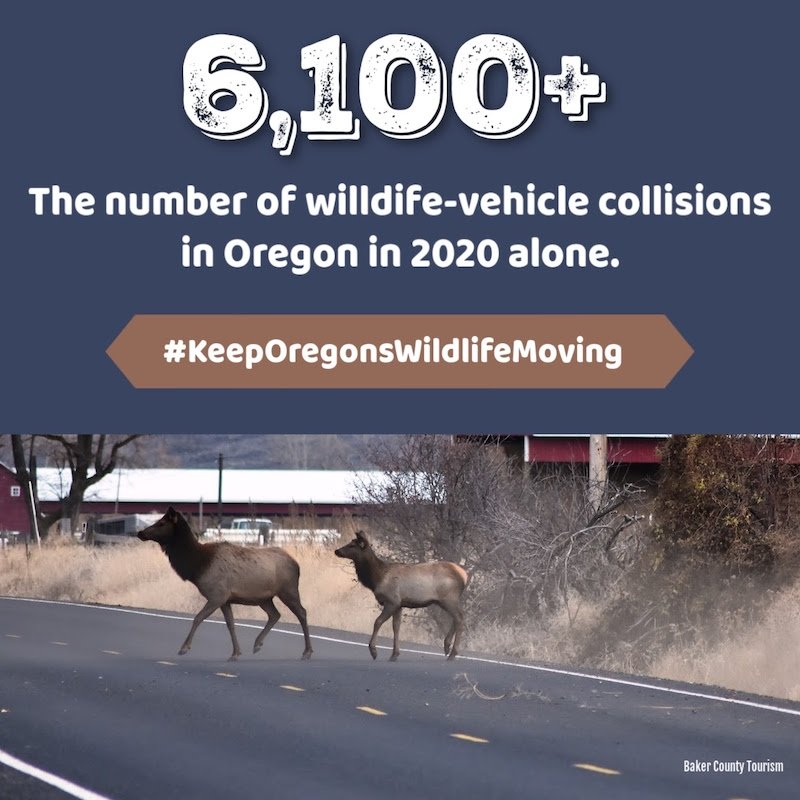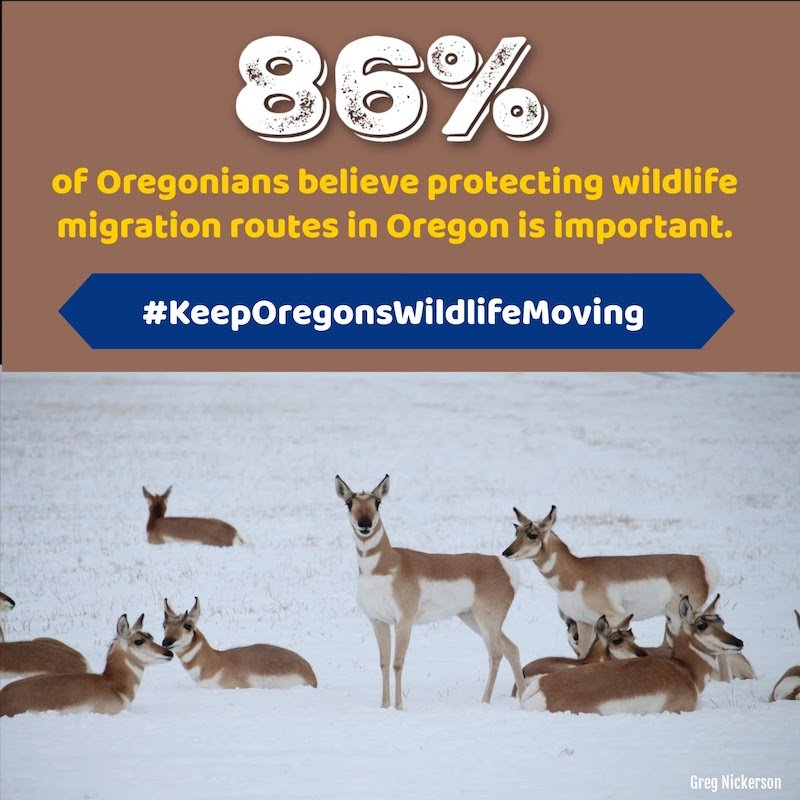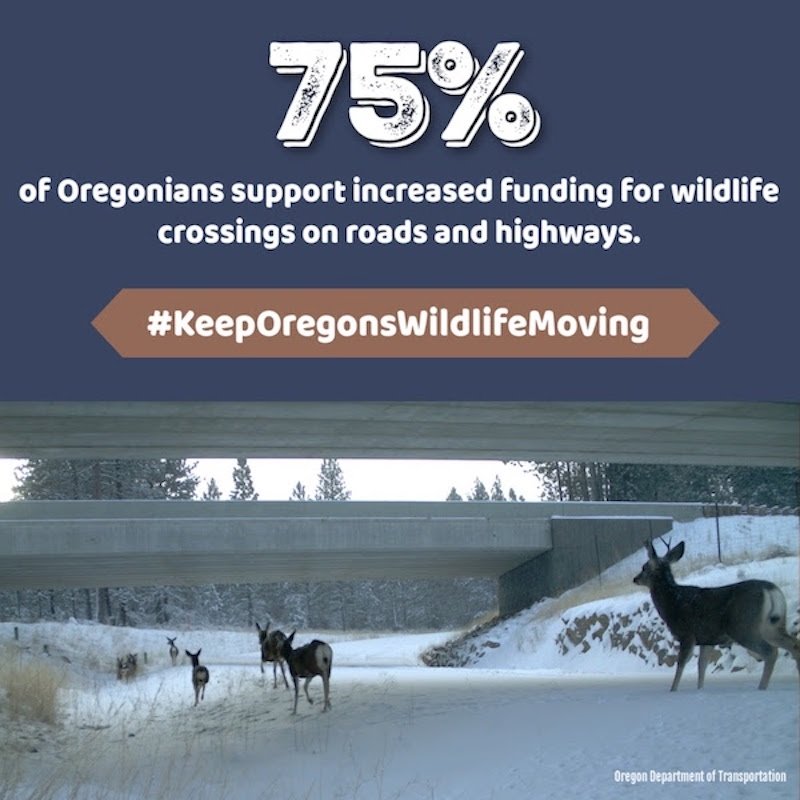Making roads safer for people and wildlife
Black bear cub.
Photo credit: Robyn Janssen
For an organization dedicated to the conservation of wildlife and wild places, an often overlooked aspect of our work is the impact of roads. Roads are not the first thing that comes to mind when you think about public lands, but did you know that the US Forest Service is responsible for managing more miles of roads (380,000) than there are in the National Highway System (164,000 miles)? In Southwest Oregon’s Rogue River-Siskiyou National Forest alone, the agency analyzed more than 4,400 miles of roads in a recent planning effort, across a 3-county area.
What is the problem with roads?
America’s road network, as currently designed, is a major impediment to wildlife migration. Fragmentation of habitat caused by roads prevents animals from accessing food and water, and can isolate wildlife populations. For animals both large and small, terrestrial and aquatic, roads reduce a species’ long-term viability. In Oregon, more mule deer are killed by motorized vehicles than through legal hunting permits.
The impacts go beyond barriers to wildlife movement. According to State Farm Insurance, Oregon drivers face a greater risk of wildlife collisions than in Washington and California. Deer and elk accounted for a vast majority of the 6,000 wildlife collisions. Oregon’s Department of Transportation (ODOT) reports that cougars, bears, fishers, martens, and various birds of prey fall victim to these collisions. The state tabulates the cost of these accidents to be about $54 million annually, and that does not include time to recover from injuries or the rare occasion of the loss of a loved one.
How do we make roads safer for wildlife…and people?
It has been a decade since ODOT constructed their first wildlife crossing. In 2012, the Lava Butte project in central Oregon was built as part of Highway 97 road improvements. While evidence shows the wildlife crossing has reduced collisions by as much as 80%, the state has been slow to invest in more projects. Momentum is now building, as a new wildlife crossing project is in the works further south on Highway 97, but Oregon only has five completed wildlife crossings. Compare that to California and Utah, each with 50. Colorado leads the pack with 69 wildlife crossings.
With the passage of the Infrastructure Investment and Jobs Act in Congress late last year, Oregon is catching on and looking to increase the number, and locations, of wildlife crossing projects. In early February, state Rep. Ken Helm (Washington County) introduced HB 4130 – the Wildlife Crossing Investment Act with strong bipartisan support. After more than a year of working groups and meetings, Rep. Helm developed a bill with more than 30 bi-cameral co-sponsors from both the House and Senate. KS Wild endorsed the legislation, and it is one of a small handful of bills we are closely tracking in the short session because of its implications for wildlife in our region.
HB 4130 (and its amendment) would allocate $7 million to ODOT for wildlife-friendly infrastructure projects. The state’s most recent transportation funding package did not include set-asides for such projects, so HB 4130-1 would invest funds with ODOT for potential projects across the state. The state would also be eligible for matching federal funds, after new provisions in the Infrastructure Investment and Jobs Act specifically set aside $350 million for wildlife-friendly projects.
What are the Wildlife Connectivity Concerns in the Klamath-Siskiyou?
In northern California and southern Oregon, the Klamath and Siskiyou Mountain ranges have an east-west orientation which is exceedingly unusual among mountain ranges, which generally run north to south. A number of wildlife migration “linkages” have been identified in the region, including the Rogue-Umpqua Divide in Oregon and the Shasta Trinity and Castle Crags linkages in California. The Siskiyou Crest straddles the Oregon/California border and is a key linkage as well.
Scientists have identified these areas are critically important to the connectivity of wildlife populations. They are “land bridges” that offer the highest quality habitat corridors between the Coast Ranges of California and Oregon with the massive volcanic ranges of the Cascade and Sierra Nevada. Unfortunately, Interstate 5 dissects each of these linkages and is a huge barrier to wildlife movement.
Southern Oregon Wildlife Crossing Coalition
KS Wild is excited to be a partner in the Southern Oregon Wildlife Crossing Coalition (SOWCC), which is a group of 17 organizations, state and federal agencies , and science advisors focused on improved wildlife passages along Interstate 5 between Ashland and the California state line along the Siskiyou Crest. This stretch of Interstate 5, known as the Siskiyou Pass, cuts through the Cascade-Siskiyou National Monument, which is the only monument set aside to protect the area’s biodiversity.
SOWCC has been around for a few months but has already raised $125,000 to analyze existing culverts and other potential overpass sites. By November 2022, the group hopes to select one or two locations where crossings could facilitate better wildlife connectivity. Thanks to the generous support of several KS Wild donors, we were able to make a small contribution to the effort which has also picked up support from Oregon’s Watershed Enhancement Board.
Political Support for Road Crossings
Despite the fact that Oregon has the highest likelihood of vehicle-wildlife collisions, Oregon has only five wildlife crossings. This is considerably fewer than other western states, including Colorado at 69, Utah and California at 50, and Nevada at 23.
Photo credit: ODOT
The prospect for building wildlife crossings in our region is dependent upon HB 4130-1 passing the Legislature this year, with continued investments over the next decade. In a recent House Environment and Natural Resources committee hearing, testimony for the bill showed its strong bipartisan support. The SOWCC was invited to provide recorded testimony alongside a diverse group of organizations and tribes, including Defenders of Wildlife, Oregon Hunters Association, Oregon Wildlife Foundation, and the Burns Paiute Tribe. While HB 4130-1 sets aside $7 million for ODOT, it does not assign funding to any one project. Projects are competing for limited dollars across the state, but HB 4130-1 is a positive first step towards increasing investments in wildlife crossings.
You can learn more about the SOWCC on their new website, where they have maps and details about the wildlife crossing feasibility study at www.myowf.org/sowcc. Students from Southern Oregon University are currently working with staff from the Cascade-Siskiyou National Monument to study trail cameras at seven crossing locations. By supporting groups like KS Wild or the SOWCC, while supporting legislators who invest in wildlife crossings, we can protect historic migratory corridors as vital for the health and longevity of wildlife populations, especially in the face of development and a changing climate.





